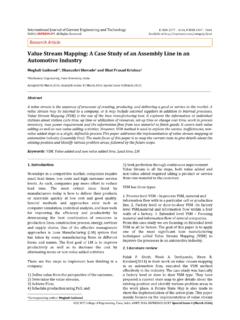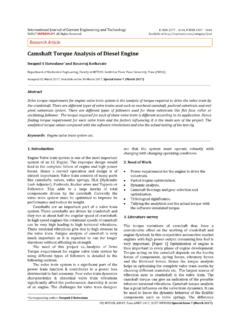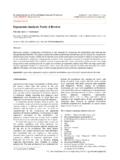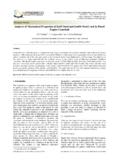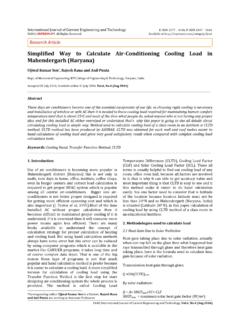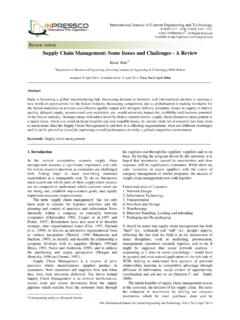Transcription of Biosynthesis of ZnO nano particles assisted by …
1 International Journal of Current Engineering and technology ISSN 2277 4106. 2013 INPRESSCO. All Rights Reserved Available at Research Article Biosynthesis of ZnO nano particles assisted by Euphorbia tirucalli (Pencil Cactus). Shilpa Hiremath*a , Vidya Ca, , M A Lourdu Antonyraja , M N Chandraprabhab , Priya Gandhia, Atishu Jaina and Kunal Ananda a Department of Chemical Engineering , R V College of Engineering, Bangalore b Department of Biotechnology, M S Ramaiah Institute of technology , Bangalore Abstract Green chemistry approach towards the synthesis of nanoparticles is in the lime light of modern nanotechnology due to growing concern to develop environment-friendly and sustainable methods. In this scenario, the focus is on development of new materials and methods for Biosynthesis of nanoparticles.
2 In the present study the ZnO nanoparticles are synthesized by biological reducing agent using Zinc Nitrate as precursor. Branches (stems) of Euphorbia tirucalli provide capping and reducing agents for the synthesis of Zno nano particles . The particle size, topography, and morphology of the synthesized ZnO product was characterized using X-ray diffraction (XRD) and Scanning Electron Microscopy (SEM). The XRD peaks coincide with literature XRD pattern for hexagonal wurtzite ZnO. The zinc oxide particles obtained are spherical in nature and were agglomerates of nanocrystallites. The average size of synthesized ZnO nanocrystallites as calculated using Scherrer's Formula is 20 nm. Keywords: Green synthesis, Biosynthesis , X ray Difraction, Scanning Electron Microscopy, Green chemistry, Euphorbia milii, latex, ZnO, nano particles 1.
3 Introduction possible applications are wide and the potential benefit to technology and society are considered to be vast, hence 1. The properties which cannot be obtained by coarse the nanotechnology can still be considered as a young one. particles can be easily obtained by fine and nano particles . The nanotechnology is the interesting area of research The strange and diverse properties can be obtained by as many things are to be explored and explained. smallness alone. That is the reason for nanotechnology Among all nano materials the metal oxides find which is the science of the tiny being so popular in last application in wide areas like catalysis, adsorption etc. few decades. Date back to the middle age nanoparticles ZnO has been commonly used in its polycrystalline form were used for their optical properties in some artwork.
4 Over hundred years in a wide range of applications. Zinc One of the first records of nanoparticles in the scientific oxide possessed many versatile properties for UV. literature date back to the middle of the 19 th century, was electronics and sensor applications. about study of studying gold colloids in the nano meter nano zinc oxide fascinates the researchers due to its range by Michael Faraday (M. Faraday, 1857). The diverse growth morphologies and wide range of principles of physics, as far as I can see, do not speak applications. Wide range of nanostructures of ZnO, makes against the possibility of maneuvering things atom by it best suited for nanoscale optoelectronics ( Huang et atom. these are the words of famous physicist Richard al, 2001) and piezoelectric nanogenerators (J. Song et al, Feynman in 1959.)
5 These words actually signify our 2006)]. As nano zinc oxide has antibacterial, antifungal complete control over the matter at atomic level and these properties it is been considered as efficient material in words were the motivation to the scientific minds of Medicine and Biotechnology field ( Wang et al;. researchers. Later in the early 1980 s, Eric Drexler coined et al, 2004; J. Sawai et al, 2004). Unique optical, the powerful word nanotechnology. Nanotechnology is a electrical and chemical properties of nano ZnO have broad field connected to basic sciences such chemistry, increased its importance in electronic sector, solar cells, physics, medicine, material science as well as to applied gas sensors, and photocatalytic degradation of chemicals technologies. The world of nanotechnology is implanting (J.
6 B. Baxter et al, 2005; Z. Ling et al, 2001; C. Y. Hsu et its footprint in the present decade very rapidly. Many al, 2008; Y. Wang et al 2008). products based on nanotechnology are in market but nano materials can be synthesized by two approaches namely bottom up and top down. In the bottom up method the small building blocks are produced and assembled into *Coresponding author: Shilpa Hiremath 176 |Proceedings of National Conference on Women in Science & Engineering (NCWSE 2013), SDMCET Dharwad Shilpa Hiremath et al International Journal of Current Engineering and technology , Special Issue1 (Sept 2013). larger structures. The parameters like morphology, crystallinity, particle size, and chemical composition can be controlled in this method. Examples: chemical synthesis, laser trapping, self-assembly, colloidal aggregation etc.
7 In the top down method coarse materials are modified to give smaller features. For example: film deposition and growth, nano imprint /lithography, etching technology , mechanical polishing etc. Various chemical methods such as hydrothermal (J. Zheng et al, 2009), precipitation (S. Suwanboon et al, 2008), sol gel (X. Wei et al, 2006) and thermal decomposition (M Salavati-Niasari et al, 2009) have been employed for the synthesis nanostructured ZnO. Most of Fig. 1. Euphorbia tirucalli (Pencil cactus). the synthetic physicochemical methods use organic solvents and toxic reducing agents majority of which are 2. Materials and Methods highly reactive and are unsafe to the environment. To avoid such implications and for sustainable synthesis of Analyitical grade Zinc nitrate was purchased from Vasa nano particles biological, biomimetic and biochemical Chemicals, Bangalore India.
8 Leaves of Pencil cactus plant approaches are desirable. Biosynthesis of nanoparticles is were collected from campus of R V College of a kind of bottom up approach where the main reaction Engineering, Bangalore occurring is reduction/oxidation. Among the various biosynthetic approaches, the use of plant extracts has of stem extract. advantages such as easy availability, safe to handle and possess a broad viability of metabolites. Fresh stems (branches) of E. tirucalli were washed with Plant extract has been used as reducing and capping water several times. Then they were cut into small pieces. agent for the synthesis of nanoparticles which could be 50 gm of cut stems were dispensed in 200 ml distilled advantageous over photochemical reduction, heat water and boiled for one hour at 80oC. The extract was evaporation, electrochemical reduction, and chemical collected in separate conical flasks.
9 The extract was reduction methods (K. Mallick et al, 2005; S. Keki et al, filtered using Whatman filter paper. 2000). Zinc oxide nano particles are synthesized by Aloe barbadensis miller leaf extract (G. Sangeetha et al, 2011) Procedure and calotropis procera (R. P. Singh et al, 2011). In the present work ZnO nanoparticles are synthesized using The 50 ml stem extract is taken in a beaker was heated. 5. leaves of pencil cactus as reducing and stabilizing agent. gm of Zinc nitrate was added to leaf extract when Euphorbia tirucalli (also known as Aveloz, Firestick temperature of extract reaches 60 C. The solution was Plants, Indian Tree Spurge, Pencil cactus, Pencil Tree, heated continuously to temperature 60-80 deg Celsius at a Sticks on Fire or Milk Bush) belongs to Euphorbiaceae low heating rate.
10 The solution starts evaporating and after family and Genus Euphorbia (Fig. 1.). It grows in dry continuous heating the yellow color paste is obtained. On areas, and is often used to feed cattle or as hedging and further heating a white color powder was observed, this is also finds some application in traditional medicine E. the end point of synthesis process. The powder thus tirucalli is a hydrocarbon plant that produces poisonous obtained is calcined in a crucible at 400 deg Celsius for latex. hrs. Many pharmacological activities of have been documented by many workers as molluscicidal 3. Characterization activity (Jurberg et al., 1985; Tiwari et al., 2003), antibacterial activity (Lirio et al., 1998), antiherpetic The product obtained was characterized by X Ray activity (Betancur-Galvis et al.)
